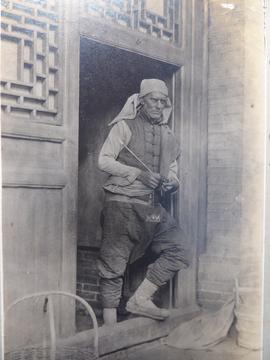Thought to have been born at Ireland Farm in the parish of Menmuir, Forfarshire around October 1764, George Don was a man of many talents, but it was botany he excelled in. At eight or nine years of age Don’s family moved to Forfar, his father working as a shoemaker in the town. Don was presumably educated at the local parish school, and on leaving was sent to Dunblane to learn the trade of watch and clock making, but throughout this time, Don was happier collecting plants, forming his own collection of dried and pressed plants (or herbarium) and classifying them using his own system.
Watchmaking, and his father’s occupation of shoe making clearly did not interest Don, as by the age of 15 he was sent to Dupplin Castle in Perthshire, the seat of the Earl of Kinnoull to work in the Gardens. It was here he made his first botanic discovery which was named after him – a moss, Gymnostonum Doniana. He also began making regular plant hunting trips to the Highlands, exploring and increasing his knowledge of the Scottish flora. He also met a young woman, Caroline Stewart whilst on a botanical ramble from Dupplin – she was later to become his wife.
In 1780 or 1781, Don moved south to England, moving from place to place for around eight years including London, Oxford and Bristol, working as a short-term gardener before moving back to Scotland and Glasgow to resume his trade as a watchmaker, although still spending his spare time botanising.
By 1797 Don had married Caroline and had obtained a plot of land in Forfar known as Dove or Doo Hillock. He built a house here and began his botanic garden which soon earned a reputation for its remarkable range, number and rarity of hardy plants.
In 1802, the position of Principal Gardener or Superintendent of the Royal Botanic Garden Edinburgh became vacant and George Don was recommended for the post despite having no formal qualifications or scientific training; proof of how highly regarded his practical experience and botanic garden at Doo Hillock was. Don was reluctant to leave Forfar, and the poor pay at the Royal Botanic Garden Edinburgh was hardly an incentive but he was finally persuaded to go and took up his new duties in Edinburgh at the end of 1802, leaving his beloved Doo Hillock in the capable hands of his father, Alexander.
Whilst in Edinburgh, Don spent a lot of time botanising with Dr. Patrick Neill, discovering many new species of wild flowers and cryptogams (lichens, mosses and fungi). He became an Associate of the Linnaean Society and attended medical classes at the University, which, although he never qualified as a doctor, he did use on his return to Forfar. He also began to publish (thanks to Patrick Neill who was a publisher) producing the first edition of Herbarium Britannicum. He also contributed to some other works, including his ‘Account of the Native Plants in the County of Forfar’ in the Revd. James Headrick’s 1813 ‘Agricultural Survey of the County of Angus’.
In 1806 Don left the Royal Botanic Garden Edinburgh to return to Doo Hillock, possibly because of a difficult relationship with Regius Keeper Daniel Rutherford (Neill believed Don far exceeded Rutherford as a botanist – Rutherford was principally a chemist) but probably more likely because he missed the freedom to botanise around ‘Angus-shire’ as he called it, in particular his favourite location for plant collecting, Glen Clova, pioneering the exploration of this area.
Unfortunately, Don concentrated so much on the exploration of the local hills and glens that he began to ignore the commercial side of his botanic garden – the nursery and market garden. George and Caroline had a large family, 15 children but only six still surviving by 1814, and with little or no income coming in, by 1813 they were dependent on neighbours for subsistence rations. Don still carried on with his excursions coming back from one of them, in the autumn of 1813, with a severe cold. Necessity meant he had to carry on working and the cold worsened. Eventually he was bedridden with a suppurating throat, and after six weeks of agony he died on the 14th January 1814 at Doo Hillock at the age of 49.
Don left his family destitute and dependant on friends and Don’s fellow botanists for charity. There were six children, the eldest, a girl, dying shortly after Don. The two eldest sons, George Don [Jr.] (1798-1856) and David Don (1799-1841) had both begun botanical careers by the time of their father’s death and both eventually did very well, George [Jr.] becoming foreman of the Chelsea Physic Garden and collecting plants for the Horticultural Society of London in Brazil, the West Indies, Sao Tome and Sierra Leone. David became the Linnaean Society’s Librarian and Professor of Botany at King’s College. Both published works as well. The three younger boys including Patrick Neill Don (1806-1876) and James Edward Smith Don (1807-1861) also had careers in horticulture in England.
The striking contrast between the wealth of knowledge accumulated by Don and the poverty he was living in at the time of his death is notable. He was buried in an unmarked grave in Forfar’s Old Parish church. By the late 1800’s there were calls for more recognition of Don’s achievements which gathered pace at the start of the 20th century and lead to a marble obelisk being erected over his grave and unveiled by George Claridge Druce in 1910.
References:
Desmond, Ray, 1994, “Dictionary of British and Irish Botanists and Horticulturists…”, Taylor and Francis and Natural History Museum, London.
Luscombe, Edward, 2007, “George Don, the Forfar Botanist, “Man of Genius””, Pinkfoot Press, Brechin.

